Splines in PyMC3¶
Introduction¶
Often, the model we want to fit is not a perfect line between some \(x\) and \(y\). Instead, the parameters of the model are expected to vary over \(x\). There are multiple ways to handle this situation, one of which is to fit a spline. The spline is effectively multiple individual lines, each fit to a different section of \(x\), that are tied together at their boundaries, often called knots. Below is an exmaple of how to fit a spline using the Bayesian framework PyMC3.
Below is a full working example of how to fit a spline using the probabilitic programming language PyMC3. The data and model are taken from Statistical Rethinking 2e by Richard McElreath’s [McElreath, 2018]. As the book uses Stan (another advanced probabilitistic programming language), the modeling code is primarily taken from the GitHub repository of the PyMC3 implementation of Statistical Rethinking. My contributions are primarily of explanation and additional analyses of the data and results.
Note that this is not a comprehensive review of splines – I primarily focus on the implementation in PyMC3. For more information on this method of non-linear modeling, I suggesting beginning with chapter 7.4 “Regression Splines” of An Introduction to Statistical Learning [James et al., 2021].
Setup¶
For this example, I employ the standard data science and Bayesian data analysis packages. In addition, the ‘patsy’ library is used to generate the basis for the spline (more on that below).
from pathlib import Path
import arviz as az
import matplotlib.pyplot as plt
import numpy as np
import pandas as pd
import pymc3 as pm
import statsmodels.api as sm
from patsy import dmatrix
WARNING (theano.tensor.blas): Using NumPy C-API based implementation for BLAS functions.
%matplotlib inline
%config InlineBackend.figure_format = "retina"
RANDOM_SEED = 8927
rng = np.random.default_rng(RANDOM_SEED)
az.style.use("arviz-darkgrid")
Cherry blossom data¶
The data for this example was the number of days (doy for “days of year”) that the cherry trees were in bloom in each year (year).
Years missing a doy were dropped.
try:
blossom_data = pd.read_csv(Path("..", "data", "cherry_blossoms.csv"), sep=";")
except FileNotFoundError:
blossom_data = pd.read_csv(pm.get_data("cherry_blossoms.csv"), sep=";")
blossom_data.dropna().describe()
| year | doy | temp | temp_upper | temp_lower | |
|---|---|---|---|---|---|
| count | 787.000000 | 787.00000 | 787.000000 | 787.000000 | 787.000000 |
| mean | 1533.395172 | 104.92122 | 6.100356 | 6.937560 | 5.263545 |
| std | 291.122597 | 6.25773 | 0.683410 | 0.811986 | 0.762194 |
| min | 851.000000 | 86.00000 | 4.690000 | 5.450000 | 2.610000 |
| 25% | 1318.000000 | 101.00000 | 5.625000 | 6.380000 | 4.770000 |
| 50% | 1563.000000 | 105.00000 | 6.060000 | 6.800000 | 5.250000 |
| 75% | 1778.500000 | 109.00000 | 6.460000 | 7.375000 | 5.650000 |
| max | 1980.000000 | 124.00000 | 8.300000 | 12.100000 | 7.740000 |
blossom_data = blossom_data.dropna(subset=["doy"]).reset_index(drop=True)
blossom_data.head(n=10)
| year | doy | temp | temp_upper | temp_lower | |
|---|---|---|---|---|---|
| 0 | 812 | 92.0 | NaN | NaN | NaN |
| 1 | 815 | 105.0 | NaN | NaN | NaN |
| 2 | 831 | 96.0 | NaN | NaN | NaN |
| 3 | 851 | 108.0 | 7.38 | 12.10 | 2.66 |
| 4 | 853 | 104.0 | NaN | NaN | NaN |
| 5 | 864 | 100.0 | 6.42 | 8.69 | 4.14 |
| 6 | 866 | 106.0 | 6.44 | 8.11 | 4.77 |
| 7 | 869 | 95.0 | NaN | NaN | NaN |
| 8 | 889 | 104.0 | 6.83 | 8.48 | 5.19 |
| 9 | 891 | 109.0 | 6.98 | 8.96 | 5.00 |
After dropping rows with missing data, there are 827 years with the numbers of days in which the trees were in bloom.
blossom_data.shape
(827, 5)
Below is a plot of the data we will be modeling showing the number of days of bloom per year.
blossom_data.plot.scatter(
"year", "doy", color="cornflowerblue", s=10, title="Cherry Blossom Data", ylabel="Day of Year"
);
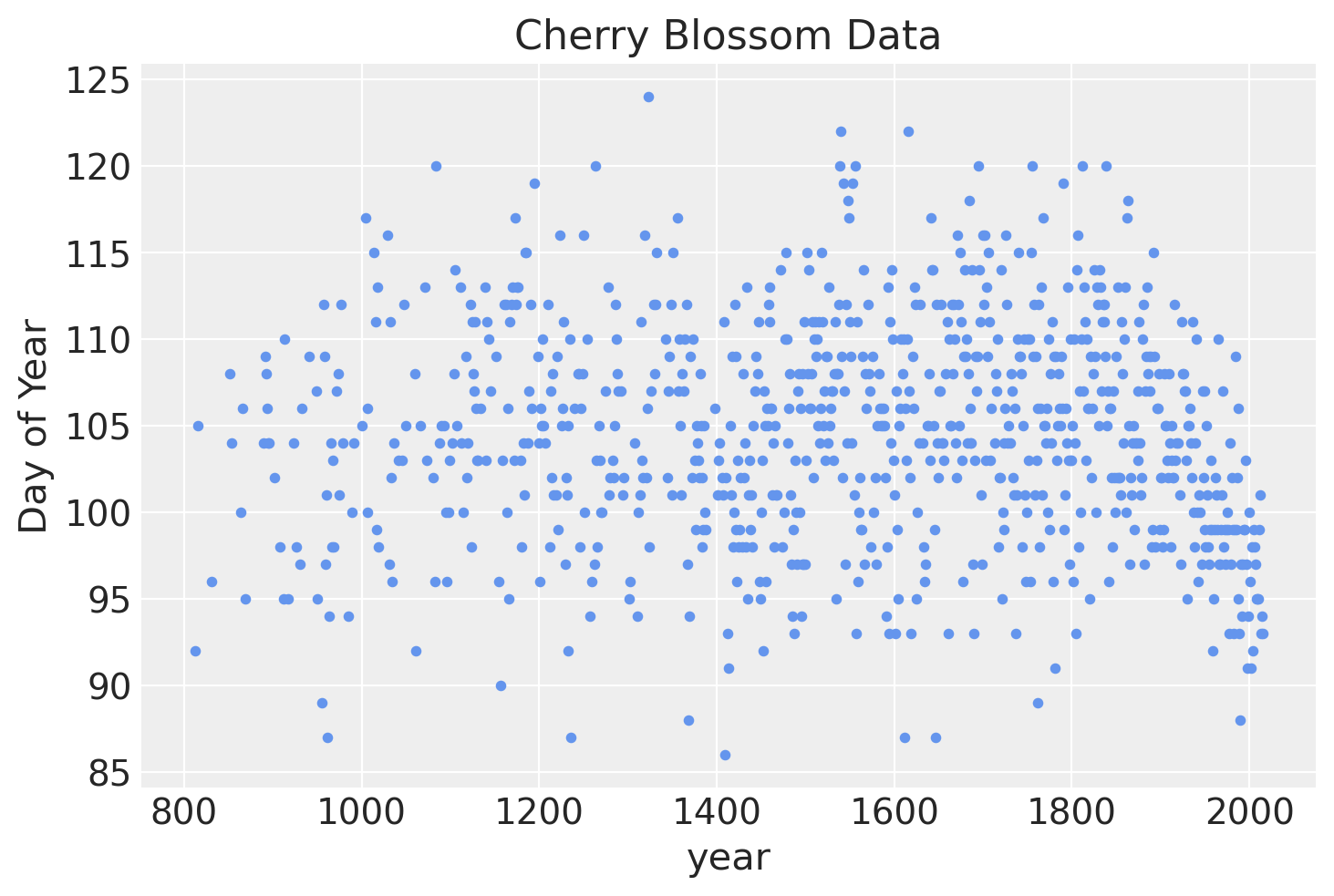
The model¶
We will fit the following model.
\(D \sim \mathcal{N}(\mu, \sigma)\)
\(\quad \mu = a + Bw\)
\(\qquad a \sim \mathcal{N}(100, 10)\)
\(\qquad w \sim \mathcal{N}(0, 10)\)
\(\quad \sigma \sim \text{Exp}(1)\)
The number of days of bloom will be modeled as a normal distribution with mean \(\mu\) and standard deviation \(\sigma\). The mean will be a linear model composed of a y-intercept \(a\) and spline defined by the basis \(B\) multiplied by the model parameter \(w\) with a variable for each region of the basis. Both have relatively weak normal priors.
Prepare the spline¶
The spline will have 15 knots, splitting the year into 16 sections (including the regions covering the years before and after those in which we have data). The knots are the boundaries of the spline, the name owing to how the individual lines will be tied together at these boundaries to make a continuous and smooth curve. The knots will be unevenly spaced over the years such that each region will have the same proportion of data.
num_knots = 15
knot_list = np.quantile(blossom_data.year, np.linspace(0, 1, num_knots))
knot_list
array([ 812., 1036., 1174., 1269., 1377., 1454., 1518., 1583., 1650.,
1714., 1774., 1833., 1893., 1956., 2015.])
Below is a plot of the locations of the knots over the data.
blossom_data.plot.scatter(
"year", "doy", color="cornflowerblue", s=10, title="Cherry Blossom Data", ylabel="Day of Year"
)
for knot in knot_list:
plt.gca().axvline(knot, color="grey", alpha=0.4);
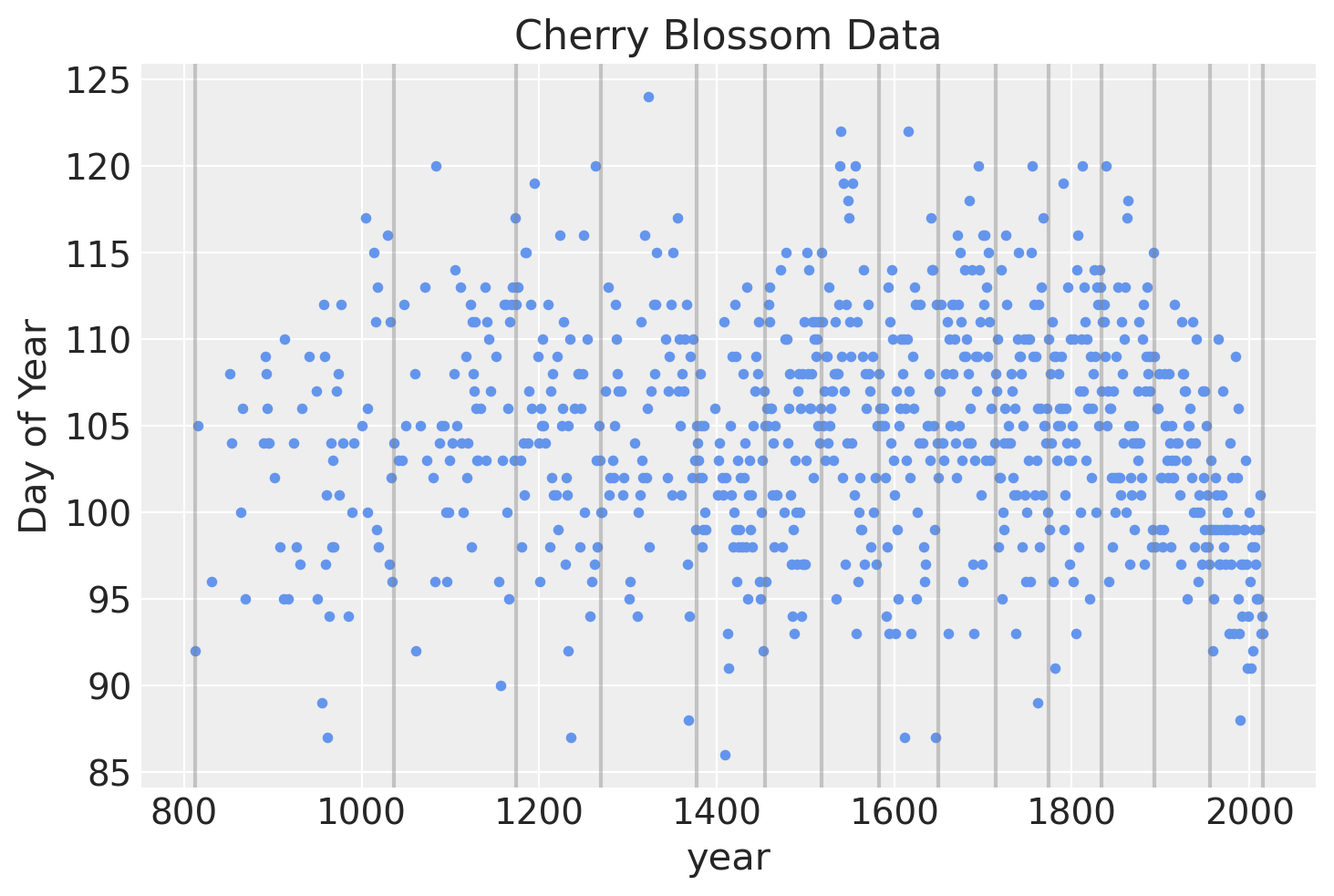
Before doing any Bayesian modeling of the spline, we can get an idea of what our model should look like using the lowess modeling from statsmodels
blossom_data.plot.scatter(
"year", "doy", color="cornflowerblue", s=10, title="Cherry Blossom Data", ylabel="Day of Year"
)
for knot in knot_list:
plt.gca().axvline(knot, color="grey", alpha=0.4)
lowess = sm.nonparametric.lowess
lowess_data = lowess(blossom_data.doy, blossom_data.year, frac=0.2, it=10)
plt.plot(lowess_data[:, 0], lowess_data[:, 1], color="firebrick", lw=2);
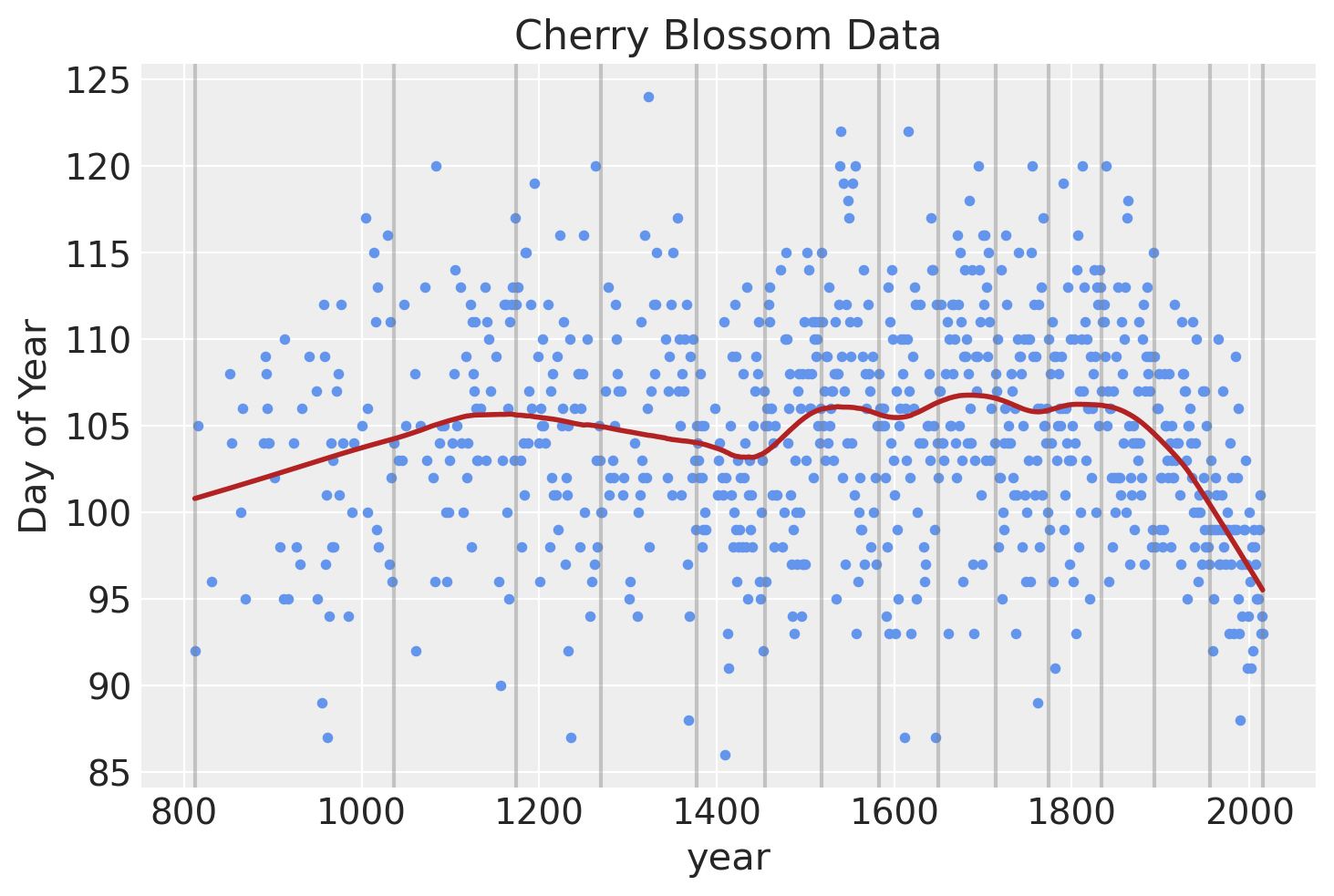
Another way of visualizing what the spline should look like is to plot individual linear models over the data between each knot. The spline will effectively be a compromise between these individual models and a continuous curve.
blossom_data["knot_group"] = [np.where(a <= knot_list)[0][0] for a in blossom_data.year]
blossom_data["knot_group"] = pd.Categorical(blossom_data["knot_group"], ordered=True)
blossom_data.plot.scatter(
"year", "doy", color="cornflowerblue", s=10, title="Cherry Blossom Data", ylabel="Day of Year"
)
for knot in knot_list:
plt.gca().axvline(knot, color="grey", alpha=0.4)
for i in np.arange(len(knot_list) - 1):
# Subset data to knot
x_range = (knot_list[i], knot_list[i + 1])
subset = blossom_data.query(f"year > {x_range[0]} & year <= {x_range[1]}")
# Create a linear model and predict values
lm = sm.OLS(subset.doy, sm.add_constant(subset.year, prepend=False)).fit()
x_vals = np.linspace(x_range[0], x_range[1], 100)
y_vals = lm.predict(sm.add_constant(x_vals, prepend=False))
# Add to plot
plt.plot(x_vals, y_vals, color="firebrick", lw=2)
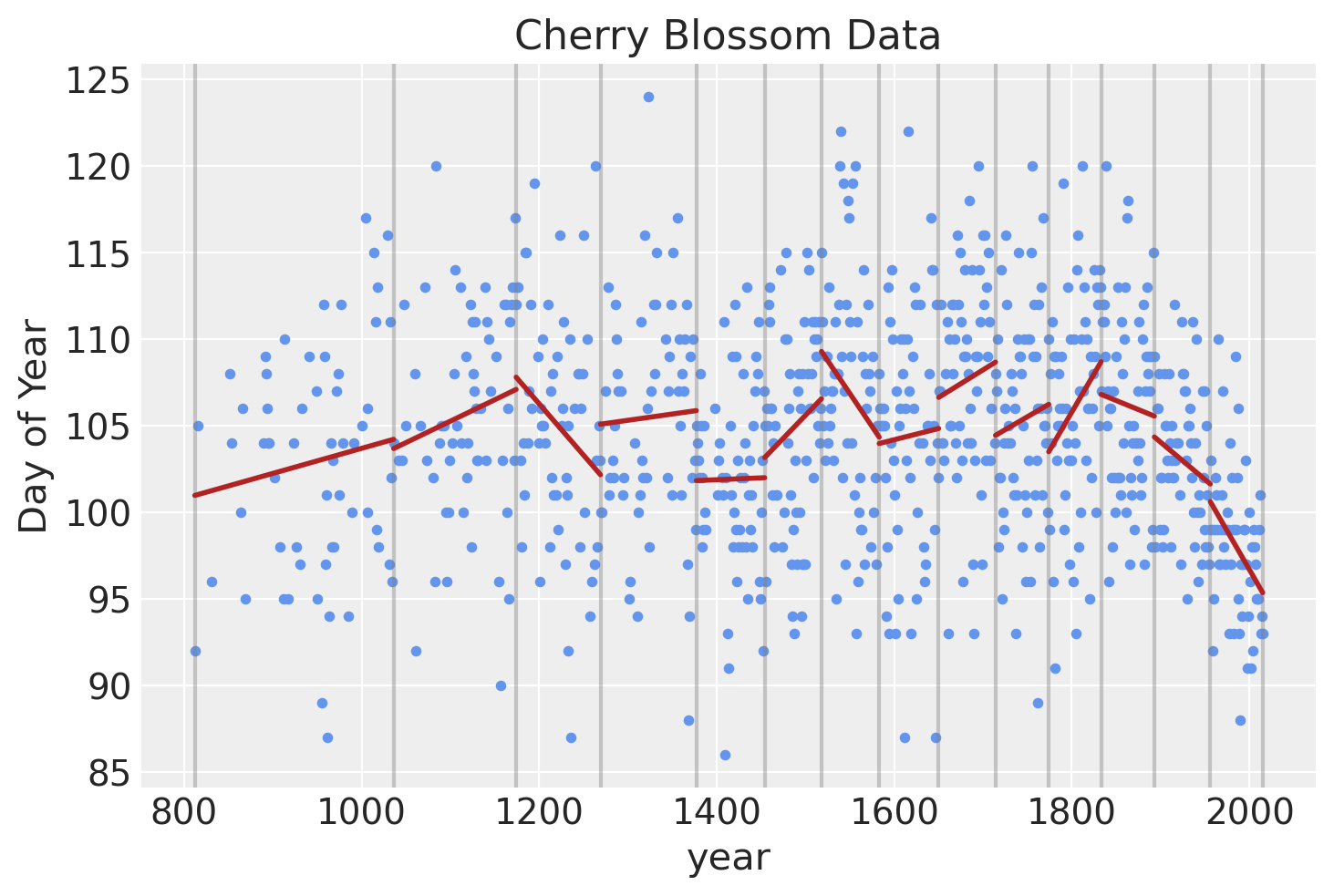
Finally we can use ‘patsy’ to create the matrix \(B\) that will be the b-spline basis for the regression. The degree is set to 3 to create a cubic b-spline.
B = dmatrix(
"bs(year, knots=knots, degree=3, include_intercept=True) - 1",
{"year": blossom_data.year.values, "knots": knot_list[1:-1]},
)
B
DesignMatrix with shape (827, 17)
Columns:
['bs(year, knots=knots, degree=3, include_intercept=True)[0]',
'bs(year, knots=knots, degree=3, include_intercept=True)[1]',
'bs(year, knots=knots, degree=3, include_intercept=True)[2]',
'bs(year, knots=knots, degree=3, include_intercept=True)[3]',
'bs(year, knots=knots, degree=3, include_intercept=True)[4]',
'bs(year, knots=knots, degree=3, include_intercept=True)[5]',
'bs(year, knots=knots, degree=3, include_intercept=True)[6]',
'bs(year, knots=knots, degree=3, include_intercept=True)[7]',
'bs(year, knots=knots, degree=3, include_intercept=True)[8]',
'bs(year, knots=knots, degree=3, include_intercept=True)[9]',
'bs(year, knots=knots, degree=3, include_intercept=True)[10]',
'bs(year, knots=knots, degree=3, include_intercept=True)[11]',
'bs(year, knots=knots, degree=3, include_intercept=True)[12]',
'bs(year, knots=knots, degree=3, include_intercept=True)[13]',
'bs(year, knots=knots, degree=3, include_intercept=True)[14]',
'bs(year, knots=knots, degree=3, include_intercept=True)[15]',
'bs(year, knots=knots, degree=3, include_intercept=True)[16]']
Terms:
'bs(year, knots=knots, degree=3, include_intercept=True)' (columns 0:17)
(to view full data, use np.asarray(this_obj))
The b-spline basis is plotted below, showing the “domain” of each piece of the spline. The height of each curve indicates how “influential” the corresponding model covariate (one per spline region) will be on model’s “inference” of that region. (The quotes are to indicate that these words were chosen to help with interpretation and are not the proper mathematical terms.) The overlapping regions represent the knots, showing how the smooth transition from one region to the next is formed.
spline_df = (
pd.DataFrame(B)
.assign(year=blossom_data.year.values)
.melt("year", var_name="spline_i", value_name="value")
)
color = plt.cm.magma(np.linspace(0, 0.80, len(spline_df.spline_i.unique())))
fig = plt.figure()
for i, c in enumerate(color):
subset = spline_df.query(f"spline_i == {i}")
subset.plot("year", "value", c=c, ax=plt.gca(), label=i)
plt.legend(title="Spline Index", loc="upper center", fontsize=8, ncol=6);
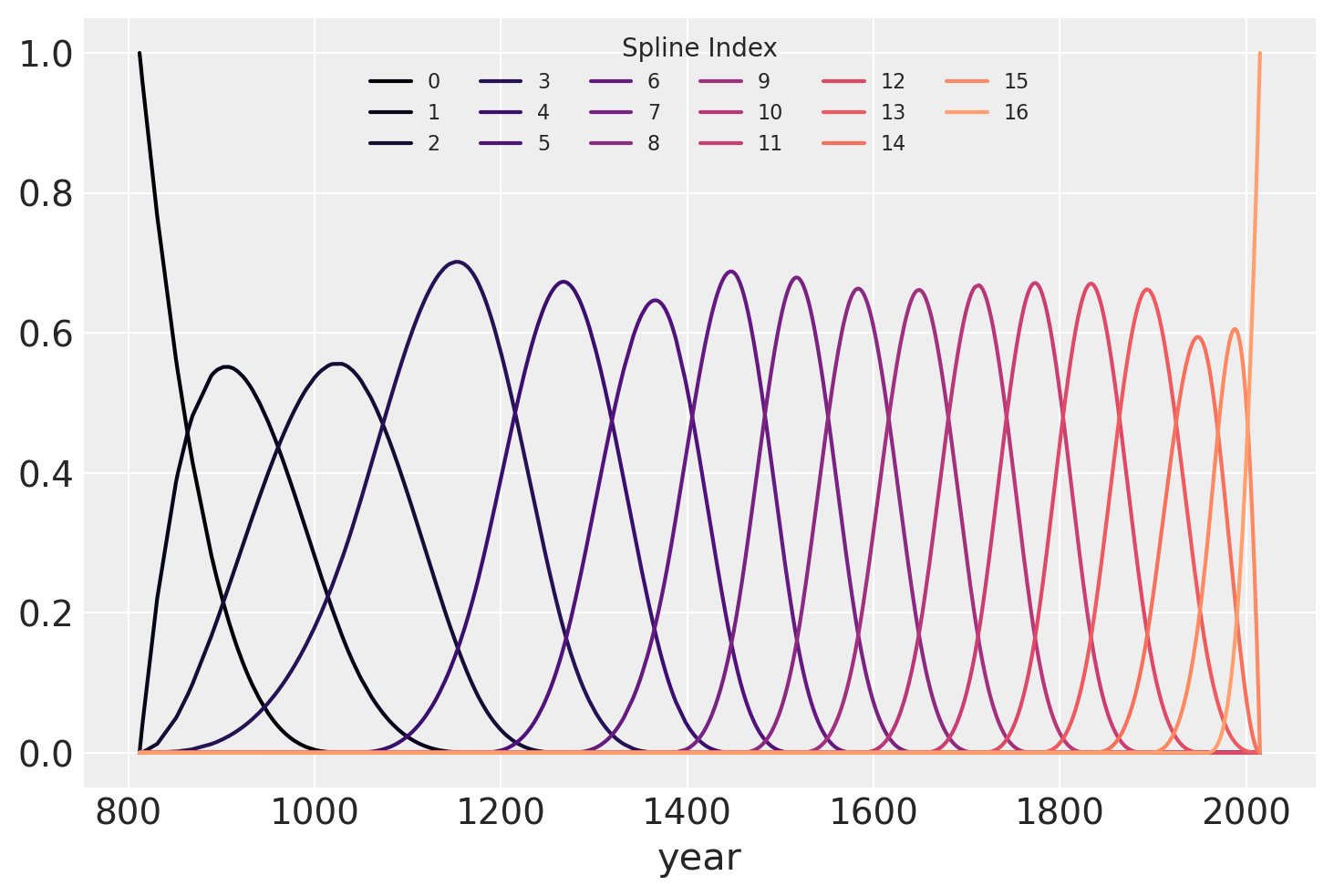
Fit the model¶
Finally, the model can be built using PyMC3.
A graphical diagram shows the organization of the model parameters (note that this requires the installation of ‘python-graphviz’ which is easiest in a conda virtual environment).
COORDS = {"obs": np.arange(len(blossom_data.doy)), "splines": np.arange(B.shape[1])}
with pm.Model(coords=COORDS) as spline_model:
a = pm.Normal("a", 100, 5)
w = pm.Normal("w", mu=0, sd=3, dims="splines")
mu = pm.Deterministic("mu", a + pm.math.dot(np.asarray(B, order="F"), w.T))
sigma = pm.Exponential("sigma", 1)
D = pm.Normal("D", mu, sigma, observed=blossom_data.doy, dims="obs")
pm.model_to_graphviz(spline_model)
with spline_model:
prior_pred = pm.sample_prior_predictive(random_seed=RANDOM_SEED)
trace = pm.sample(
draws=1000,
tune=1000,
random_seed=RANDOM_SEED,
chains=4,
return_inferencedata=True,
)
post_pred = pm.sample_posterior_predictive(trace, random_seed=RANDOM_SEED)
trace.extend(az.from_pymc3(prior=prior_pred, posterior_predictive=post_pred))
Auto-assigning NUTS sampler...
Initializing NUTS using jitter+adapt_diag...
Multiprocess sampling (4 chains in 4 jobs)
NUTS: [sigma, w, a]
Sampling 4 chains for 1_000 tune and 1_000 draw iterations (4_000 + 4_000 draws total) took 138 seconds.
Analysis¶
Now we can analyze the draws from the posterior of the model.
Fit parameters¶
Below is a table summarizing the posterior distributions of the model parameters. The posteriors of \(a\) and \(\sigma\) are quite narrow while those for \(w\) are wider. This is likely because all of the data points are used to estimate \(a\) and \(\sigma\) whereas only a subset are used for each value of \(w\). (It could be interesting to model these hierarchically allowing for the sharing of information and adding regularization across the spline.) The effective sample size and \(\widehat{R}\) values all look good, indiciating that the model has converged and sampled well from the posterior distribution.
az.summary(trace, var_names=["a", "w", "sigma"])
| mean | sd | hdi_3% | hdi_97% | mcse_mean | mcse_sd | ess_bulk | ess_tail | r_hat | |
|---|---|---|---|---|---|---|---|---|---|
| a | 103.629 | 0.770 | 102.183 | 105.072 | 0.018 | 0.013 | 1778.0 | 2057.0 | 1.0 |
| w[0] | -1.778 | 2.201 | -5.824 | 2.322 | 0.033 | 0.026 | 4491.0 | 3049.0 | 1.0 |
| w[1] | -1.636 | 2.065 | -5.666 | 2.050 | 0.035 | 0.028 | 3588.0 | 3202.0 | 1.0 |
| w[2] | -0.245 | 1.934 | -3.808 | 3.386 | 0.033 | 0.029 | 3373.0 | 2971.0 | 1.0 |
| w[3] | 3.364 | 1.486 | 0.673 | 6.304 | 0.027 | 0.019 | 2938.0 | 2749.0 | 1.0 |
| w[4] | 0.199 | 1.504 | -2.525 | 3.014 | 0.027 | 0.020 | 3215.0 | 3082.0 | 1.0 |
| w[5] | 2.098 | 1.587 | -0.876 | 4.977 | 0.029 | 0.021 | 2996.0 | 3163.0 | 1.0 |
| w[6] | -3.557 | 1.475 | -6.397 | -0.766 | 0.026 | 0.019 | 3109.0 | 2866.0 | 1.0 |
| w[7] | 5.529 | 1.453 | 2.827 | 8.254 | 0.027 | 0.019 | 2992.0 | 3056.0 | 1.0 |
| w[8] | -0.030 | 1.555 | -2.987 | 2.825 | 0.027 | 0.021 | 3450.0 | 3259.0 | 1.0 |
| w[9] | 2.224 | 1.599 | -0.551 | 5.354 | 0.028 | 0.020 | 3173.0 | 3232.0 | 1.0 |
| w[10] | 3.781 | 1.585 | 0.790 | 6.689 | 0.029 | 0.021 | 3033.0 | 2487.0 | 1.0 |
| w[11] | 0.359 | 1.518 | -2.493 | 3.276 | 0.027 | 0.020 | 3085.0 | 2892.0 | 1.0 |
| w[12] | 4.160 | 1.515 | 1.092 | 6.839 | 0.028 | 0.020 | 2899.0 | 2948.0 | 1.0 |
| w[13] | 1.077 | 1.611 | -1.885 | 4.196 | 0.030 | 0.023 | 2916.0 | 2701.0 | 1.0 |
| w[14] | -1.818 | 1.785 | -5.058 | 1.627 | 0.031 | 0.023 | 3387.0 | 3157.0 | 1.0 |
| w[15] | -5.974 | 1.879 | -9.402 | -2.428 | 0.031 | 0.022 | 3691.0 | 2960.0 | 1.0 |
| w[16] | -6.161 | 1.857 | -9.653 | -2.652 | 0.031 | 0.022 | 3701.0 | 3171.0 | 1.0 |
| sigma | 5.956 | 0.148 | 5.683 | 6.234 | 0.002 | 0.002 | 4558.0 | 2793.0 | 1.0 |
The trace plots of the model parameters look good (fuzzy caterpillars), further indicating that the chains converged and mixed.
az.plot_trace(trace, var_names=["a", "w", "sigma"]);
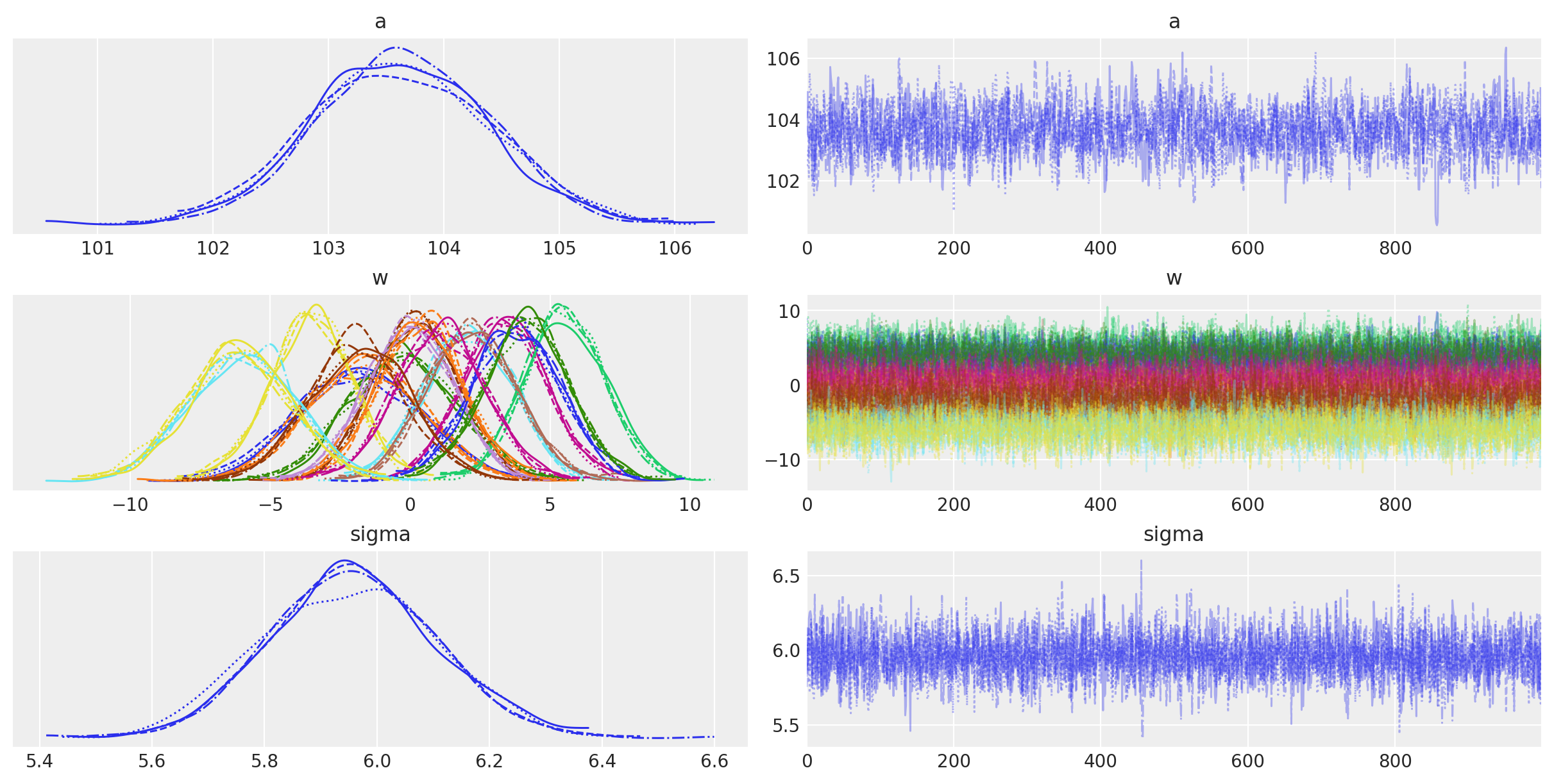
az.plot_forest(trace, var_names=["w"], combined=False);
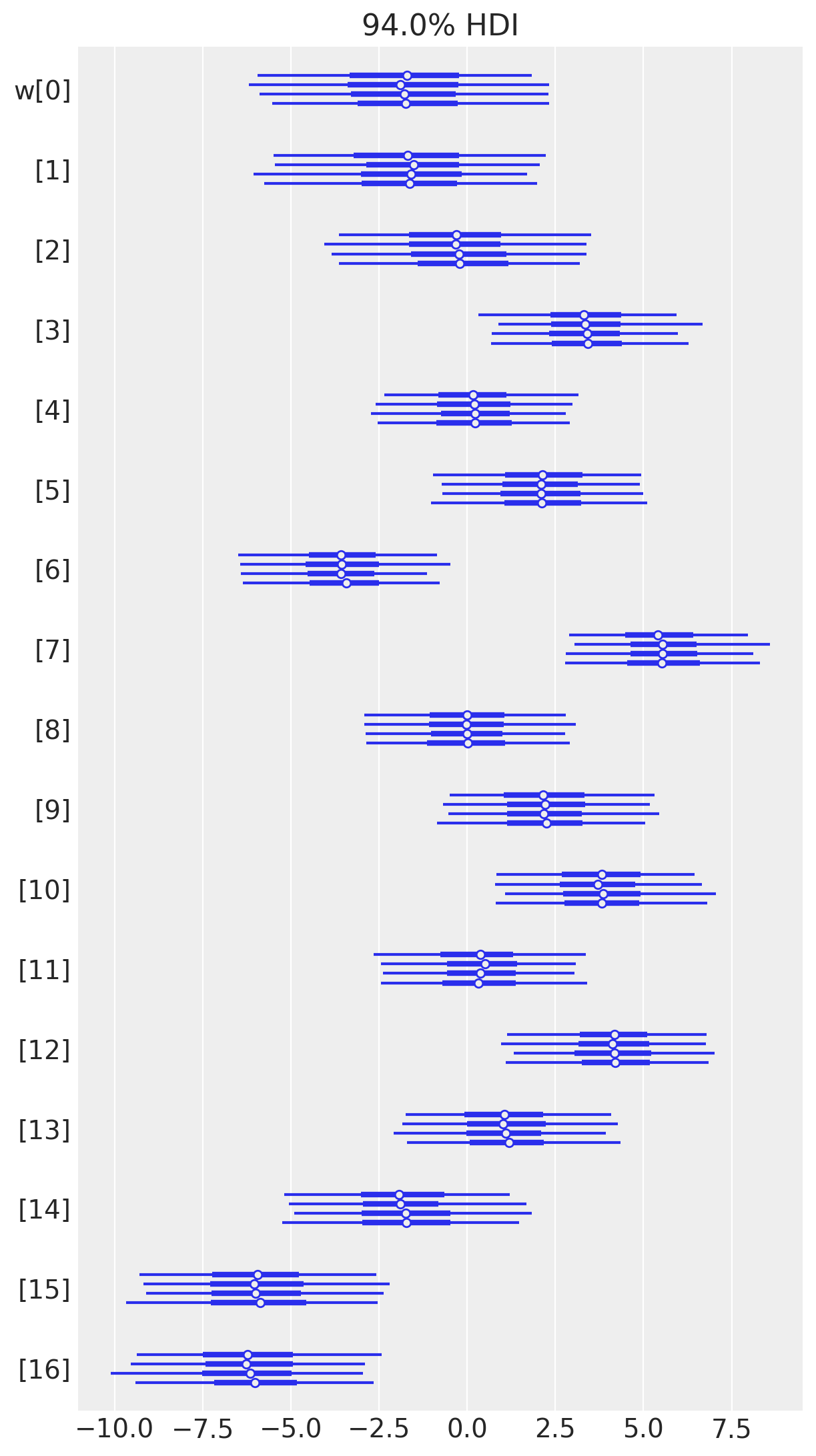
Another visualization of the fit spline values is to plot them multiplied against the basis matrix. The knot boundaries are shown in gray again, but now the spline basis is multipled against the values of \(w\) (represented as the rainbow-colored curves). The dot product of \(B\) and \(w\) – the actual computation in the linear model – is shown in blue.
wp = trace.posterior["w"].values.mean(axis=(0, 1))
spline_df = (
pd.DataFrame(B * wp.T)
.assign(year=blossom_data.year.values)
.melt("year", var_name="spline_i", value_name="value")
)
spline_df_merged = (
pd.DataFrame(np.dot(B, wp.T))
.assign(year=blossom_data.year.values)
.melt("year", var_name="spline_i", value_name="value")
)
color = plt.cm.rainbow(np.linspace(0, 1, len(spline_df.spline_i.unique())))
fig = plt.figure()
for i, c in enumerate(color):
subset = spline_df.query(f"spline_i == {i}")
subset.plot("year", "value", c=c, ax=plt.gca(), label=i)
spline_df_merged.plot("year", "value", c="black", lw=2, ax=plt.gca())
plt.legend(title="Spline Index", loc="lower center", fontsize=8, ncol=6)
for knot in knot_list:
plt.gca().axvline(knot, color="grey", alpha=0.4);
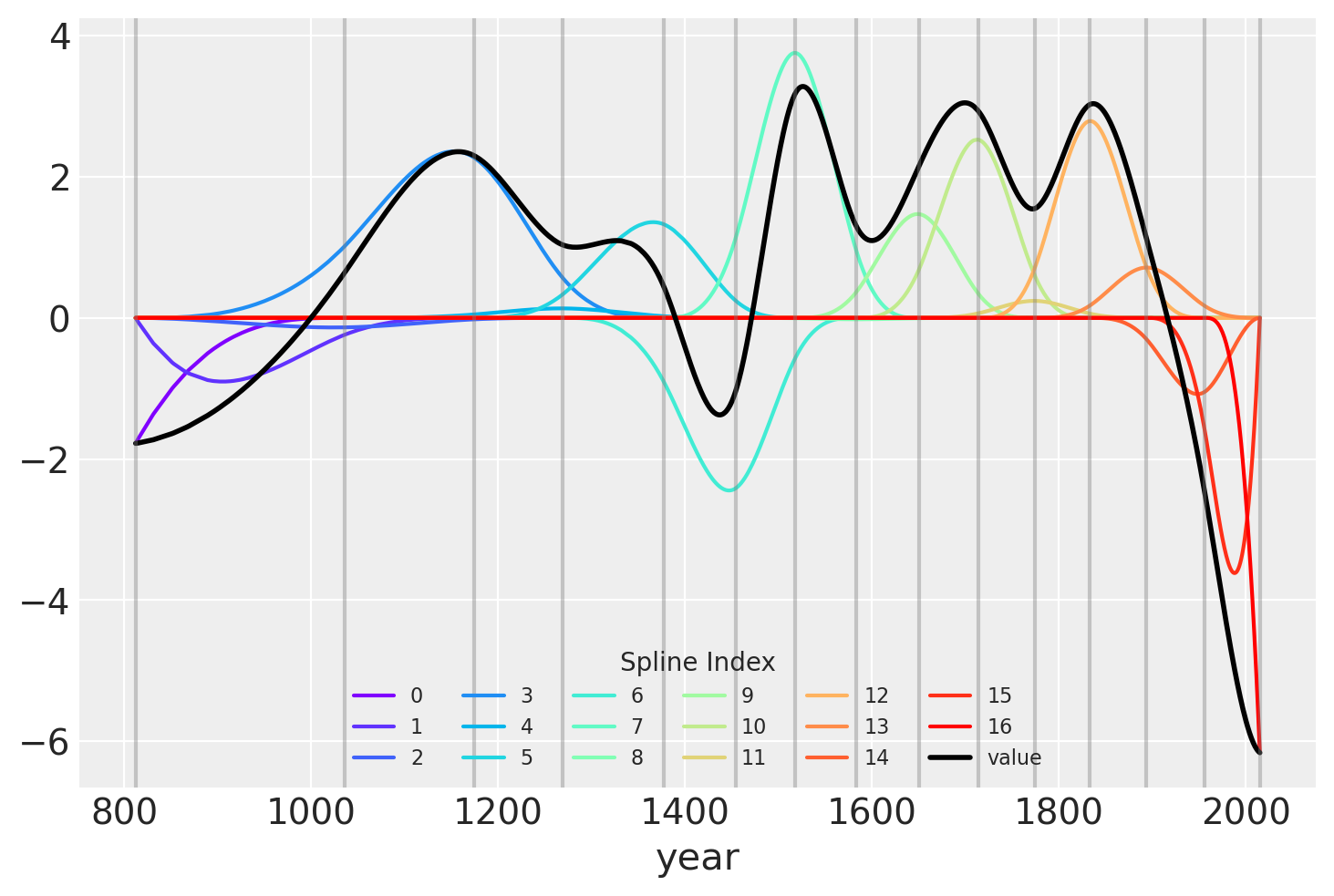
Model predictions¶
Lastly, we can visualize the predictions of the model using the posterior predictive check.
post_pred = az.summary(trace, var_names=["mu"]).reset_index(drop=True)
blossom_data_post = blossom_data.copy().reset_index(drop=True)
blossom_data_post["pred_mean"] = post_pred["mean"]
blossom_data_post["pred_hdi_lower"] = post_pred["hdi_3%"]
blossom_data_post["pred_hdi_upper"] = post_pred["hdi_97%"]
blossom_data.plot.scatter(
"year",
"doy",
color="cornflowerblue",
s=10,
title="Cherry blossom data with posterior predictions",
ylabel="Day of Year",
)
for knot in knot_list:
plt.gca().axvline(knot, color="grey", alpha=0.4)
blossom_data_post.plot("year", "pred_mean", ax=plt.gca(), lw=3, color="firebrick")
plt.fill_between(
blossom_data_post.year,
blossom_data_post.pred_hdi_lower,
blossom_data_post.pred_hdi_upper,
color="firebrick",
alpha=0.4,
);
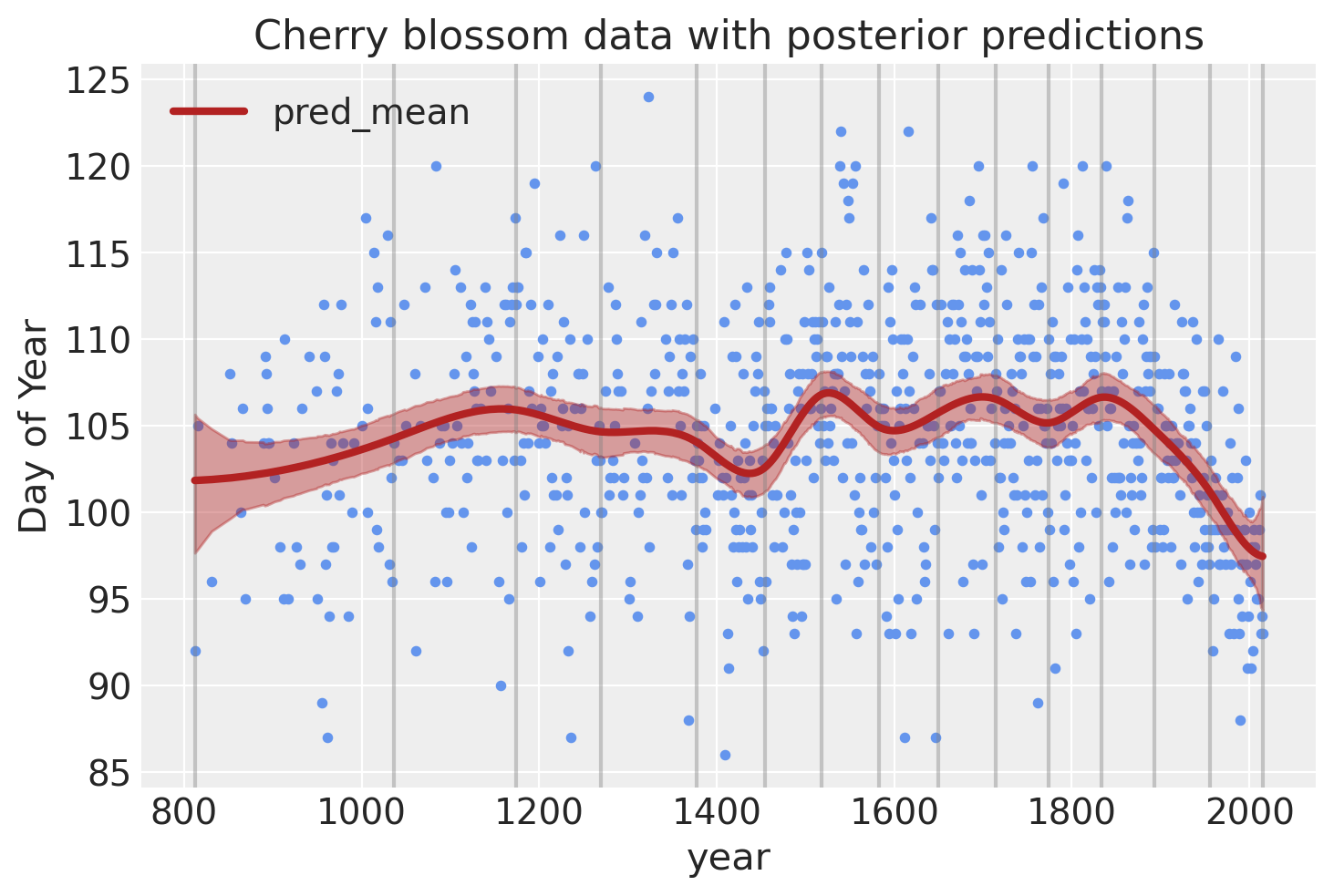
References¶
- 1
Richard McElreath. Statistical rethinking: A Bayesian course with examples in R and Stan. Chapman and Hall/CRC, 2018.
- 2
Daniela James, Gareth ad Witten, Trevor Hastie, and Robert Tibshirani. An Introduction to Statistical Learning. Springer, 2021. ISBN 978-1-0716-1420-4. doi:https://doi.org/10.1007/978-1-0716-1418-1.
I would like to recognize the discussion “Spline Regression in PyMC3” on the PyMC3 Discourse as the inspiration of this example and for the helpful discussion and problem-solving that improved it further.
Watermark¶
%load_ext watermark
%watermark -n -u -v -iv -w -p theano,xarray,patsy
Last updated: Wed Oct 13 2021
Python implementation: CPython
Python version : 3.9.7
IPython version : 7.28.0
theano: 1.1.2
xarray: 0.19.0
patsy : 0.5.2
arviz : 0.11.4
matplotlib : 3.4.3
numpy : 1.21.2
pymc3 : 3.11.4
statsmodels: 0.13.0
pandas : 1.3.3
Watermark: 2.2.0
License notice¶
All the notebooks in this example gallery are provided under the MIT License which allows modification, and redistribution for any use provided the copyright and license notices are preserved.
Citing PyMC examples¶
To cite this notebook, use the DOI provided by Zenodo for the pymc-examples repository.
Important
Many notebooks are adapted from other sources: blogs, books… In such cases you should cite the original source as well.
Also remember to cite the relevant libraries used by your code.
Here is an citation template in bibtex:
@incollection{citekey,
author = "<notebook authors, see above>"
title = "<notebook title>",
editor = "PyMC Team",
booktitle = "PyMC examples",
doi = "10.5281/zenodo.5832070"
}
which once rendered could look like:
- Joshua Cook , Tyler James Burch . "Splines in PyMC3". In: PyMC Examples. Ed. by PyMC Team. DOI: 10.5281/zenodo.5832070